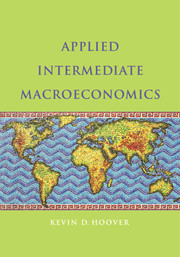Book contents
- Frontmatter
- Brief Contents
- Contents
- Acknowledgments
- To the Student
- To the Teacher
- Part I Introduction
- Part II The National Accounts
- 2 The National Accounts and the Structure of the Economy
- 3 Understanding Gross Domestic Product
- 4 Measuring Prices and Inflation
- Part III Trends and Cycles
- Part IV Financial Markets
- Part V Aggregate Supply
- Part VI Aggregate Demand
- Part VII Macroeconomic Dynamics
- Part VIII Macroeconomic Policy
- Part IX Macroeconomic Data
- Symbols
- Glossary
- Guide to Online Resources
- Index
- References
2 - The National Accounts and the Structure of the Economy
from Part II - The National Accounts
Published online by Cambridge University Press: 05 June 2012
- Frontmatter
- Brief Contents
- Contents
- Acknowledgments
- To the Student
- To the Teacher
- Part I Introduction
- Part II The National Accounts
- 2 The National Accounts and the Structure of the Economy
- 3 Understanding Gross Domestic Product
- 4 Measuring Prices and Inflation
- Part III Trends and Cycles
- Part IV Financial Markets
- Part V Aggregate Supply
- Part VI Aggregate Demand
- Part VII Macroeconomic Dynamics
- Part VIII Macroeconomic Policy
- Part IX Macroeconomic Data
- Symbols
- Glossary
- Guide to Online Resources
- Index
- References
Summary
Before we can understand the economy, we need to know how to describe and measure it. In this chapter we focus on gross domestic product (GDP), the most central quantity in macroeconomics. What is it? How is it created? How do we measure it? What is its relationship to other important quantities? How does it change over time?
How Big Is the Economy?
Since ancient days, bad times have followed good, and good times have followed bad. Since ancient days, people have looked to their leaders to promote the good times and soften the bad. In the Bible, Joseph predicts seven fat years to be followed by seven lean years, and advises Pharaoh to store grain against the coming famine. When agriculture dominated economies, the cycle of good and bad times mostly reflected the cycle between fair weather and drought or flood. In modern industrial economies, the causes of the cycle are not so readily visible. An important object of macroeconomics is to help us to understand these causes and to learn what policies might promote the good times and soften the bad. Economists may start with theories, but to apply those theories to actual economies and to judge whether they are really working as intended, we need some method of keeping score: how rich is the country (or how large is the economy)? How fast is it growing?
The news media constantly quote statistics that aim to answer these questions: The U.S. economy (i.e., the gross domestic product or GDP) fell by 5.4 percent per year in the first quarter of 2008. The U.S. economy in 2008 was 3.3 times larger than the Japanese economy (i.e., U.S. GDP was $14,260 billion and Japanese GDP was $4,329 billion). Most people understand that GDP and its growth rate report the economic score, yet few actually understand what they really mean. They are, in fact, the central quantities in macroeconomics. Almost every other quantity that might interest us is either a component of GDP (such as consumption, investment, wages, or profits) or connected to it through important economic relationships (such as unemployment or inflation).
- Type
- Chapter
- Information
- Applied Intermediate Macroeconomics , pp. 29 - 70Publisher: Cambridge University PressPrint publication year: 2011



